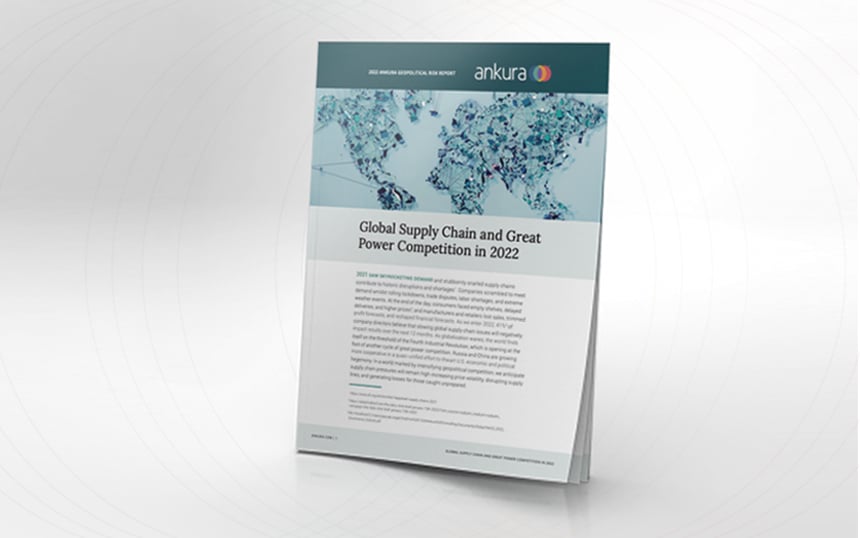Annual Geopolitical Risk Report
Global Supply Chain & Great Power Competition in 2022
2021 saw skyrocketing demand and stubbornly snarled supply chains contribute to historic disruptions and shortages. Companies scrambled to meet demand amidst rolling lockdowns, trade disputes, labor shortages, and extreme weather events. At the end of the day, consumers faced empty shelves, delayed deliveries, and higher prices, and manufacturers and retailers lost sales, trimmed profit forecasts, and reshaped financial forecasts. As we enter 2022, 41% (1) of company directors believe that slowing global supply chain issues will negatively impact results over the next 12 months. As globalization wanes, the world finds itself on the threshold of the Fourth Industrial Revolution, which is opening at the foot of another cycle of great power competition. Russia and China are growing more cooperative in a quasi-unified effort to thwart U.S. economic and political hegemony. In a world marked by intensifying geopolitical competition, we anticipate supply chain pressures will remain high-increasing price volatility, disrupting supply lines, and generating losses for those caught unprepared. Supply chain managers will have to contend with six key growing challenges this year, including:
Labor transformation will intensify the global talent competition
The pandemic brought unprecedented disruption to labor markets that will scar the employment landscape for years. It will come as no surprise that 70% (2) of directors expect increased competition for talent this year. The International Labor Organization (ILO) estimates the global labor shortage at 75 million in 2021 and 23 million in 2022. Many developed countries are facing acute labor challenges in industries relevant to supply chains such as manufacturing, truck driving, logistics, and construction. Job vacancies are at all-time highs in the U.S., the EU, and the UK.
Previously, robust immigration could have offset some of the labor shortages, but the recent wave of nationalist political sentiment has limited the ability of governments to fully leverage immigration. In the U.S., legal international migration flows have shrunk by over 75% (3) since 2016. In the EU, legal migration continues to increase, but labor market integration is more problematic than for native-born workers. This is not expected to change soon. As most Western countries face a demographic decline in short order, companies should start preparing for shallower labor pools.
In the post-WTO world, interventionist economic policies will reverberate across supply chains
Economic nationalism has been steadily rising over the last decade as the returns from globalization have diminished. The pandemic, which exposed the weaknesses of complex, opaque, just-in-time supply chains, only reinforced this trend. As the OECD (4) puts it, “the time is over when industrial policies were considered words not to be spoken in decent circles.” Rather, more countries are pursuing industrial policies to develop new capabilities, enhance productivity or employment, out-compete China, and accelerate economic transformation. Brazil, Costa Rica, Chile, China, Ethiopia, the EU, France, Italy, India, Japan, Turkey, the UK, the U.S., South Africa have launched plans to mobilize public and private capital to strengthen industrial capabilities.
Semiconductors are the poster child of global industrial policies, but these policies target a spectrum of other critical sectors, including pharmaceuticals and biologics, agriculture and food commodities, AI, cloud, edge computing, infrastructure, critical minerals, solar panels, and advanced batteries. Many countries are also encouraging companies to increase the resiliency of their supply chains to ensure they can sustain shocks by reducing dependencies and promoting redundancy. These policies will reverberate across supply chains. Public and private investments in new production will generate new opportunities for companies, as long as they abide by localization requirements. However, such conditions could cause workforce availability bottlenecks, as current supply chains have relied on specific pools of high and low skilled workers in specific geographical areas. Similarly, the effort to increase supply chain resiliency is likely to raise costs, which consumers may or may not accept. Finally, as industrial incentives multiply and create trade distortions, commercial disputes will likely rise and lead to retaliatory measures, therefore increasing supply chain risks.
Global resource competition will intensify
Despite the return of a multi-lateralist administration in Washington, the post-World War II rules-based order continues to fray. In many areas, global cooperation remains at a standstill even in the face of dire challenges, as pointedly noted.
Download the Full Report

